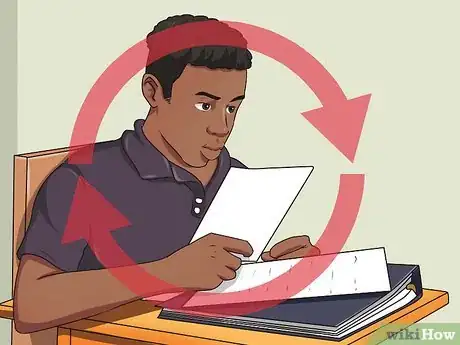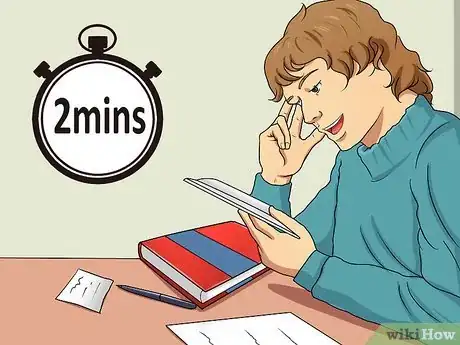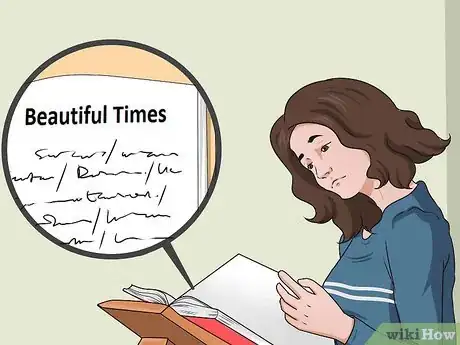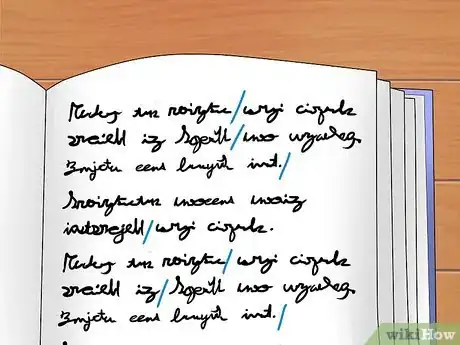This article was co-authored by Stephanie Wong Ken, MFA. Stephanie Wong Ken is a writer based in Canada. Stephanie's writing has appeared in Joyland, Catapult, Pithead Chapel, Cosmonaut's Avenue, and other publications. She holds an MFA in Fiction and Creative Writing from Portland State University.
wikiHow marks an article as reader-approved once it receives enough positive feedback. This article received 13 testimonials and 83% of readers who voted found it helpful, earning it our reader-approved status.
This article has been viewed 414,842 times.
Learning how to read fast, or speed read, can be a useful skill if you are trying to get through a reading list quickly or go through a long text. Before you can speed up your reading abilities, you will need to determine your average reading speed and practice several methods to improve your reading speed.
Steps
Determining the Speed You Are Reading
-
1Understand the average reading speeds for adults. An average college student can read between 200 and 300 words per minute (wpm) if they are reading fiction and non-technical materials. A strong reader can read 500-700 wpm and an excellent reader can read 1000 wpm. This means the average reader may be five times slower than a good reader and ten times slower than an excellent reader. Improving your reading speed if you are an average or even a good reader means you will need to try several techniques for speeding up your reading rate and be willing to practice improving your reading rate for a consistent period of time.[1] Though your reading speed may fluctuate based on the type of text used and your level of familiarity with the reading material, in general:
- A poor reader has a wpm rate of 100-110 words.
- An average reader has a wpm rate of 200-240 wpm.
- A good reader has a wpm rate of 300-400 wpm.
- An excellent reader has a wpm rate of 700-1000 wpm.
- Keep in mind ESL readers may struggle to maintain more than 200-300 wpm when reading a text that is not in their native tongue. Many educators argue that ESL readers should try to maintain a slower reading rate to ensure they can comprehend the text.
-
2Be aware of the relationship between your reading speed and your reading comprehension rate. Being a faster reader does not necessarily mean you will be able to comprehend the finer details or points in the text. In fact, your ability to comprehend a text may decrease as your reading speed increases. Less-commonly known words or longer words take longer to read and comprehend. Speeding through the text may cause you to skip over key words and your understanding of the text may start to fade. [2]
- Many linguistic experts argue that it’s important to improve your vocabulary and broaden your exposure to many different types of texts, in addition to improving your reading speed. This will ensure your reading comprehension rate stays at the same level or improves along with your reading speed.
Advertisement -
3Test your reading speed. Determine your reading speed using a practice text and a timer. Use a text that is at least five to ten pages long on standard 8” x 11” paper.[3]
- Count the number of words in five lines of the practice text. Divide this number of words by five and you will have the average number of words per line in the text. For example: 70 words/5 lines = 14 words per line.
- Count the number of text lines on five pages of the text and divide this number by five to determine the average number of lines per page. Then, multiply the average number of lines per page by the average number of words per line and you will get the average number of words per page. For example: 195 lines/5 pages = 39 lines per page. 39 lines per page x 14 words per line = 546 words per page.
- Once you have the average words per line and words per page, time yourself reading the text for one minute. Try to read as fast as possible, but also make sure you understand the idea or point in each sentence.
- After one minute, stop reading and count how many lines you read in one minute. Multiply the number of lines you read by the average words per line to determine your words per minute rate. For example: You managed to read 26 lines in one minute. 26 x 14 words per line = 364 words per minute. Your wpm rate is 364 words per minute, which means you are considered a good reader.
Accelerating Your Reading Speed
-
1Practice a rate build up exercise. This exercise will help you learn how to read material and process it more quickly. The purpose of this activity is to reread “old” material quickly and to glide on to the new material until you can read and comprehend it faster. You will need a practice text that is at least 1-2 pages long and a timer.
- Set the timer for 60 seconds and try to read as much of the text as possible. Stop the timer at 60 seconds.
- Start the timer at 60 seconds again and read again from the beginning of the text. Try to read more material during this 60-second period than you did in the first reading period.
- Repeat this exercise a third and a fourth time. Try to read more of the text during each exercise until you read more of the text during the fourth time.
-
2Do a timed repeated reading. This is a longer activity where you will read the same short passage over and over again until you improve your reading speed. Keep your reading speed in mind as you complete this exercise and use it as a benchmark. Try to improve your reading speed so it becomes faster during every rereading.
- Begin with a 100-word paragraph. Set the timer to two minutes.
- Try to read the paragraph four times during the two minutes. Aim for a reading speed of at least 200 words per minute.
- Once you are able to read the paragraph four times in two minutes, move on to reading a 200-word paragraph eight times in four minutes.
- As you continue to do this reading drill, your reading speed should improve.
-
3Use a ruler or pen as a marker or tracker on the page. You may slow down when you read due to rereading or regression, where you skip back over a phrase or term due to an inability to follow the lines of text on the page. To help make your eye placement on the page more accurate and efficient, you can use a pen as a guide.[4]
- Hold the pen in your dominant hand, with the cap on. Hold it under your hand, flat against the page. Set the timer for one minute.
- Use the pen to underline each line of text as you read. Keep your eye fixed above the tip of the pen. The pen will act as a useful marker on the page and will help you maintain a consistent reading speed.
- At the end of one minute, calculate your wpm based on the number of lines you read. Note if your reading rate improves with the use of the pen.
-
4Try not to talk to yourself as you read. Many readers tend to vocalize the text as they read, where they move their lips and read words out loud. You may also subvocalize, where you talk to yourself in your head as you read silently. Both of these habits can slow down your reading rate, as speaking is a relatively slow activity. The average speaking rate is 250 wpm, which is not considered a very fast reading rate.[5]
- Limit your reading habits so it involves only your eyes and your brain, rather than actual speech. Vocalization will slow your reading down and cause you to try to do two things at once, rather than focus on the text.
- Poetry and plays are texts that are meant to be performed, so it can be difficult not to vocalize as you read these texts. In fact, vocalizing while you read these texts can help you understand them better. You may find speaking the dialogue in a play or a line of poetry can enhance your understanding. However, it will likely slow down your reading rate.
-
5Preview the text before you read it in full. If you are aiming to improve your reading rate and your reading comprehension rate, you can do a 30-60 second preview of the text before you read it in full.
- Start by reading the title of the text, such as the chapter title.
- Read all the headings and subheadings.
- Look over any marked, italicized or bolded text.
- Look at any pictures or illustrations, as well as any charts or graphs.
- Read the first sentence of every paragraph, particularly the first sentence of the first and last paragraphs of the text.
- After you have previewed the text, ask yourself: What is the main idea of the text? What is the author’s purpose for writing the text? What is the style of the writing: formal, informal, medical, legal? You should be able to answer these basic questions if you preview the text properly.
-
6Chunk the text into sections. Chunking is when you group words in the text into short, meaningful phrases that are three to five words long. Rather than read every word, and risk forgetting the beginning of a sentence by the time you get to the end of the sentence, you can chunk the text into groups of words that will help you comprehend the text quickly and effectively. Many teachers will use chunking in the classroom to help students comprehend large texts. You may be given a statement of purpose to guide you as you go through the text and look for specific sections you can chunk together.
- Keep in mind excessive chunking can limit or reduce your comprehension of the text. Try to use the statement of purpose given to you by your teacher to guide you as you chunk the text.
-
7Read the text with a goal in mind. Approaching the text with a question or in a questioning manner can make you a stronger reader and possibly a faster reader. Look at the text as if you were searching for something, or trying to reach a goal.
- Take the heading or title of a chapter and turn it into a question. For example, if a heading of a section in the text is “The Causes of Global Warming”, you can switch it into a question, such as: “What are the causes of global warming?” You will then approach the text with a goal, and will be looking for the key answers to this question in the text. Your reading will now be goal-oriented, allowing you to possibly read faster and not lose your reading comprehension ability.
-
8Challenge your reading rate by practicing with more difficult texts. Once you start to improve your reading rate using assigned texts in a class or out of a book that is considered suitable for your reading level, you should try to vary the types of texts you practice with to improve your reading rate. Varying your texts will also expand your vocabulary and help you avoid having to reread or pause over a certain term or word when you are reading.
- Keep in mind legal material and medical material are not meant to be read quickly, so it can be difficult to maintain a high reading rate when you practice with these types of texts. Take your time with these types of texts and work on improving your reading rate slowly, over time.
Community Q&A
-
QuestionIt it possible to read a 500 page book in 15 days?
 Community AnswerAnything is possible! You just need to set aside time to read and make sure you properly comprehend the book. The above article should help you.
Community AnswerAnything is possible! You just need to set aside time to read and make sure you properly comprehend the book. The above article should help you. -
QuestionHow can I become better at remembering what I read?
 Community AnswerAfter every five pages, write down what you remember about what you read.
Community AnswerAfter every five pages, write down what you remember about what you read. -
QuestionHow can I focus on reading when I could be doing something else, like swimming or playing on my phone?
 Community AnswerPut aside any distractions like your phone, your games and other stuff. Try reading in a calm area, where any distractions are unlikely. You'll also find this is easier when the book you're reading is a book you enjoy.
Community AnswerPut aside any distractions like your phone, your games and other stuff. Try reading in a calm area, where any distractions are unlikely. You'll also find this is easier when the book you're reading is a book you enjoy.
References
- ↑ https://www.sciencedirect.com/science/article/abs/pii/S0749596X19300786
- ↑ https://www.theatlantic.com/health/archive/2014/03/is-speed-reading-possible/284326/
- ↑ https://scholarwithin.com/reading-speed-test
- ↑ https://www.linkedin.com/learning/learning-speed-reading-2014/using-your-hand-to-guide-your-eyes
- ↑ https://www.mentalfloss.com/posts/how-many-words-per-minute-do-people-speak
About This Article
To read fast, hold a ruler or pen on the page and move it so it's always under the line you're currently reading, which will help prevent you from re-reading a sentence by mistake. Also, make sure you're not mouthing the words or saying them out loud as you read, which can cause you to read significantly slower. You can also train yourself to read faster by timing yourself as you read a passage and then trying to read it again in a shorter amount of time. To learn how to do other reading drills that can help you read faster, scroll down!










































































